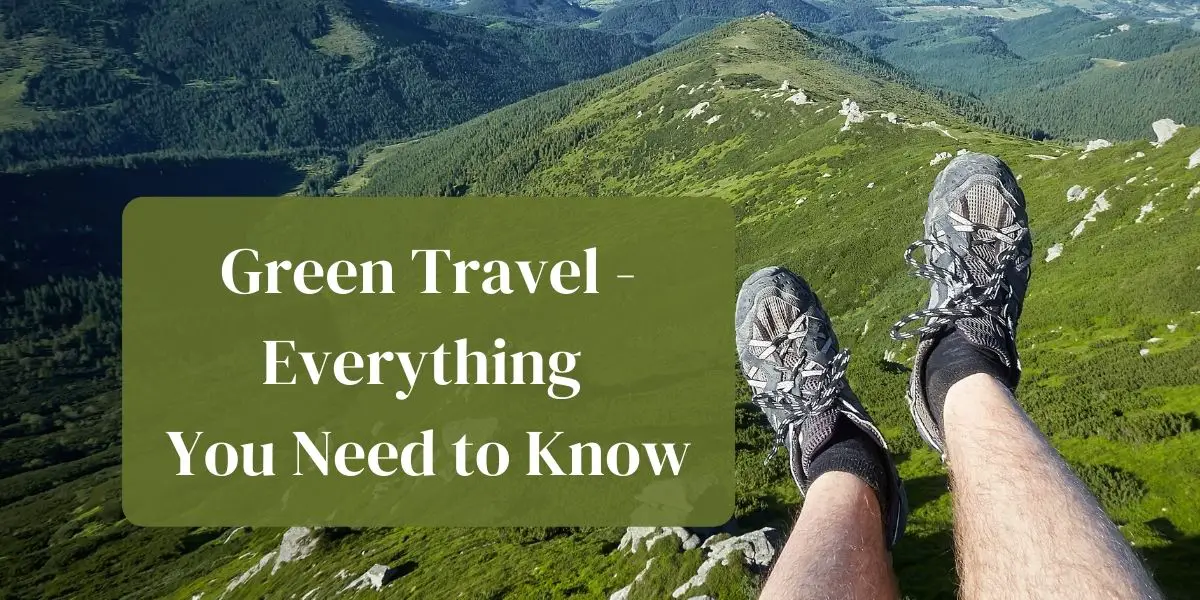Travel can broaden our horizons, foster multicultural understanding, and give excellent material for Instagram. Unfortunately, travel may also have a negative impact on Mother Earth. So we’ve put up a guide on reducing the environmental effect of our trip – green travel – even if we don’t have to cancel our plans.
Table of Contents
- Go green travel – the need to know
- Before You Go: Packing and Leaving Home
- Getting There: Choosing How to Travel
- During Your Stay: Keeping it Green
Go green travel – the need to know
Green travel is a wide concept with two major subcategories: It initially and mainly refers to responsible travel methods that prioritize environmental, social, and economic sustainability. It can also refer to eco-tourism, which is defined as responsible travel to natural regions. And, while we appreciate our readers in the Galapagos and the Arabian Desert, we’ll be focused on the first term for the purposes of this post.
Why should we bother being green in our travel habits? To begin, the transportation sector in the United States is responsible for around 40% of the nation’s fossil-fuel related carbon dioxide (CO2) emissions – one of the major gases responsible for climate change. Reducing our collective transportation footprint (also known as our environmental impact) has the potential to dramatically reduce the quantity of CO2 we send into the atmosphere. Is it feasible, however, to add concerns about “going green” to the strains of travel while remaining sane? Fortunately, yes. It is not only feasible (and very simple) to keep the environment in mind while traveling, but in many situations, green travel habits may save us some, uh, green.
Before You Go: Packing and Leaving Home
Green travel begins before we even leave the house. Follow these packing and home preparation suggestions to be ready for eco-friendly travel and to reduce your house’s carbon impact while you’re gone.
- Pack light. The more weight trains, aircraft, and vehicles must transport, the more fuel they consume, and the more greenhouse gases (those that cause global warming) are released into the environment.
- Take a reusable water bottle and a shopping bag with you. Toss the bag in the luggage and have the reusable water bottle ready for filling up at water fountains – utilizing both products will help reduce unnecessary packaging when traveling.
- Before you go, please recycle. If you bought new items before your vacation (for example, an iPhone charger or a new tube of toothpaste), recycle the cardboard wrappers before you go. It will avoid the stress of “I can’t find a recycling station anywhere” that can occur when you are away from home (just me?).
- Turn off, and then disconnect, all lights and devices. Nobody is going to use that couch-side lamp while you’re gone, unless the roommate is sticking put for the holidays. Turning off electronics reduces energy consumption and saves money on your power bill. Unplug any gadgets to have an even larger impact, as they can “leech” electricity even when not turned on.
- Reduce the temperature on the thermostat. The same argument as before: An empty room does not require heating, and keeping it warm wastes energy. If you have your own water heater, turn that down as well.
- Stop delivering newspapers. A short phone call to the newspaper business can save forests (and the paper kid’s tired little legs) during your absence.
Getting There: Choosing How to Travel
Airplanes have been demonized by the green driving (it does take a lot of fuel to keep those things aloft), but the cleanest mode of transportation may really depend on how far we have to travel. The fundamental breakdown, in terms of pounds of CO2 emitted per mile, is as follows: Buses, trains, hybrid vehicles, and coach seats on narrow planes have the lowest carbon footprints, emitting less than 12 pounds of CO2 per mile. Regular vehicles and coach or regional aircraft are classified as having a “medium carbon footprint.” SUVs and first-class planes are the worst carbon polluters, emitting more than one pound of CO2 every mile. In practice, what does this mean? Continue reading.
- Buses are the best alternative. Yes, bus travels may be lengthy, and the person next to you may have a bowel movement. However, this is a danger with any mode of public transportation, and the environmental advantages of motor coaches are impressive: A couple that takes the bus automatically reduces their carbon footprint by nearly half – even when compared to a hybrid! And, as compared to flying, that same bus-riding pair will reduce their emissions by 55 to 75 percent (whoa). Just make sure the bus is full or almost so; otherwise, the benefits are less obvious.
- Instead of flying, use the train or bus for shorter journeys. This emits three to seven times less gas than flying.
- Couples and single travelers should consider the following: A nonstop coach flight nearly usually beats driving, especially for distances more than 500 miles (ca. 805 km) (but a full bus or train is still the best option).
- If renting a car, choose the smallest vehicle feasible and, if available, a hybrid.
- If flying, select the most direct route feasible; takeoffs and landings consume the most fuel. Fly coach rather than first class (less leg space equals more people on the plane, which means more bang for your money on fuel). Pick an energy-efficient plane as well. This one can be difficult because the information isn’t always readily available. However, several airlines, such as Southwest, have begun upgrading their planes to make them more energy efficient, and new jet types (such as Boeing’s 787 Dreamliner) are designed to burn up to 20% less fuel. If you have the time and interest, contact the airline and inquire about their environmental policies.
- Offset your trip expenses. Why not plant a few trees to offset the carbon dioxide emitted during transportation? Trees turn CO2 into oxygen, which is beneficial to us (obviously, we require oxygen to exist) and beneficial to the environment since CO2 “consumed” by trees is not released into the sky. Fortunately, there are a plethora of apps available to perform the planting for you. It is worth mentioning, however, that carbon offsetting has received some criticism: Critics argue that offset plans offer people a “free pass” to consume the same number of resources as before (since they can “make up for it”) rather than taking active effort to decrease their environmental impact.
During Your Stay: Keeping it Green
There are actions you can do to reduce your environmental effect in transportation, whether you’re staying in a hotel or staying with relatives.
- Selecting a (green) hotel: There are several certifying agencies for green hotels (though they are not without their detractors), as well as a plethora of information for the would-be green visitor. Whether or not a hotel displays a green label in the lobby window, you may obtain a sense of the company’s environmental ethics by visiting their website or phoning them and asking a few questions: Is the hotel locally owned and run, and/or is it staffed by locals? What kinds of recycling initiatives exist? What steps does the hotel take to decrease its energy consumption?
- In a hotel. To reduce your energy use, implement the following easy practices: Take brief showers and turn off the water while brushing your teeth. When you leave the room, turn off the TV, lights, and heat or air conditioning. If you are staying for many nights, reuse your linens and towels rather than having them washed and replaced every day.
- Alternatively, you might simply abandon the hotel. Instead, stay with relatives, friends, or someone you’ve never met before.
- Getting around: When feasible, take public transportation, ride a bike, or walk. If you must drive, consider the following green driving tips: Avoid abrupt starts and stops, idling, keeping tires properly inflated, combining trips, keeping load light, and adhering to speed limits.
- Shopping: Purchase meals, snacks, and other items from local sellers (and remember to bring your reusable bag!).
- Eating: The fundamental concepts of green eating apply almost anyplace. Make a goal of include one local or organic item in each meal on the family table (just make sure to suggest it in a friendly way to the chefs).







